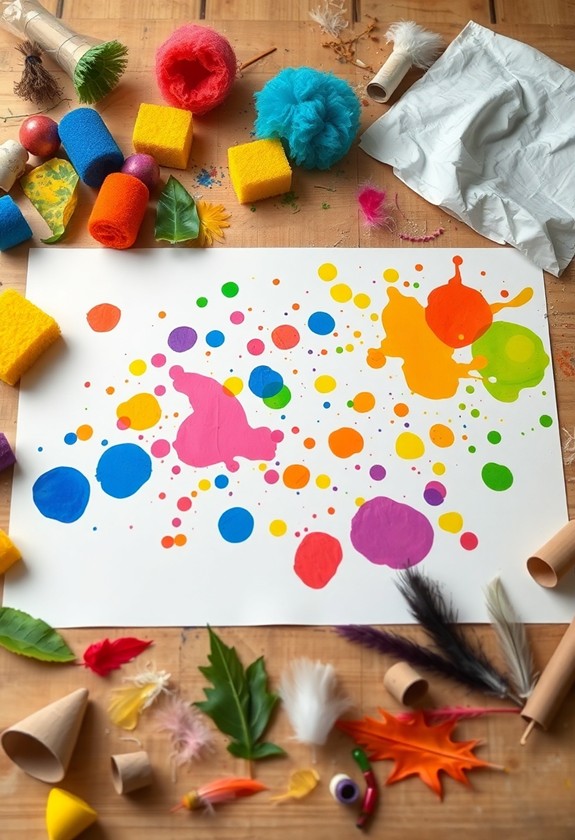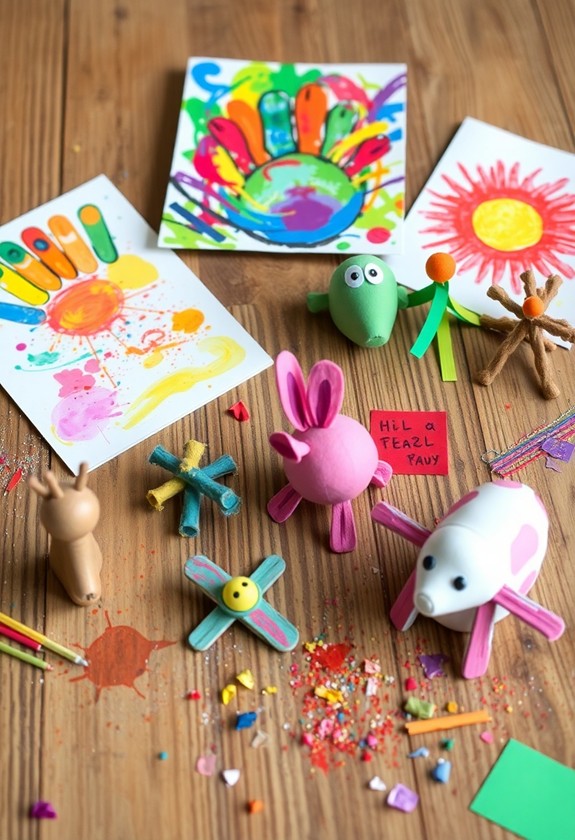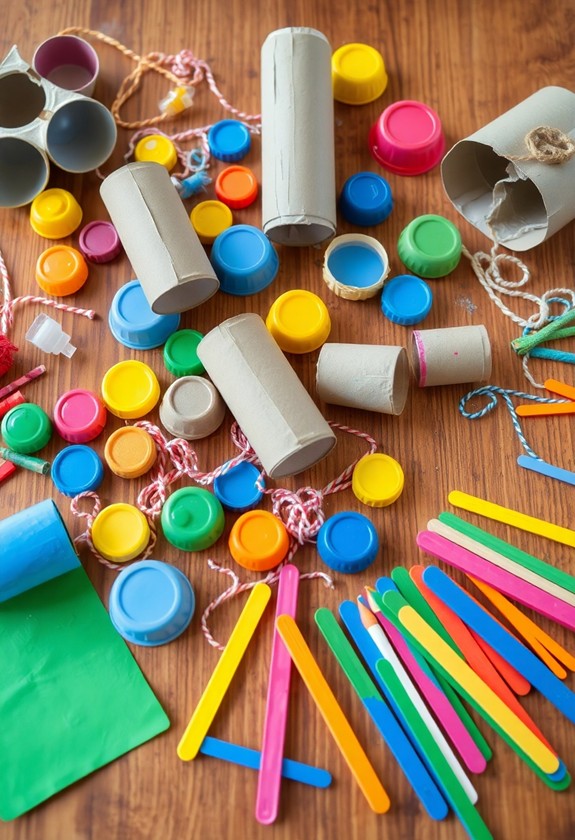Get ready for artistic fun with your toddler! These 7 cheap process art ideas will spark creativity without breaking the bank. Try finger painting with pudding for a tasty, messy adventure. Create unique patterns with bubble wrap printing. Make mesmerizing marbled art using shaving cream and food coloring. Paint with cooked spaghetti for wild textures! Transform coffee filters into colorful masterpieces with markers and water. Sculpt imaginative creations with homemade playdough. Or take a nature walk and make beautiful collages from found treasures. These activities are perfect for developing fine motor skills and encouraging self-expression. But wait, there's more to investigate in the world of toddler art!
Creative Highlights
- Finger painting with pudding offers an edible, mess-friendly option that enhances sensory exploration and creativity.
- Bubble wrap printing creates unique patterns while developing fine motor skills and introducing cause-and-effect concepts.
- Shaving cream marbling provides a mesmerizing art experience that develops fine motor skills and encourages color mixing.
- Spaghetti painting uses cooked pasta as a tool, promoting textural creativity and hand-eye coordination.
- Coffee filter art employs washable markers and water to create blended color effects, fostering creativity with easy cleanup.
Finger Painting With Pudding
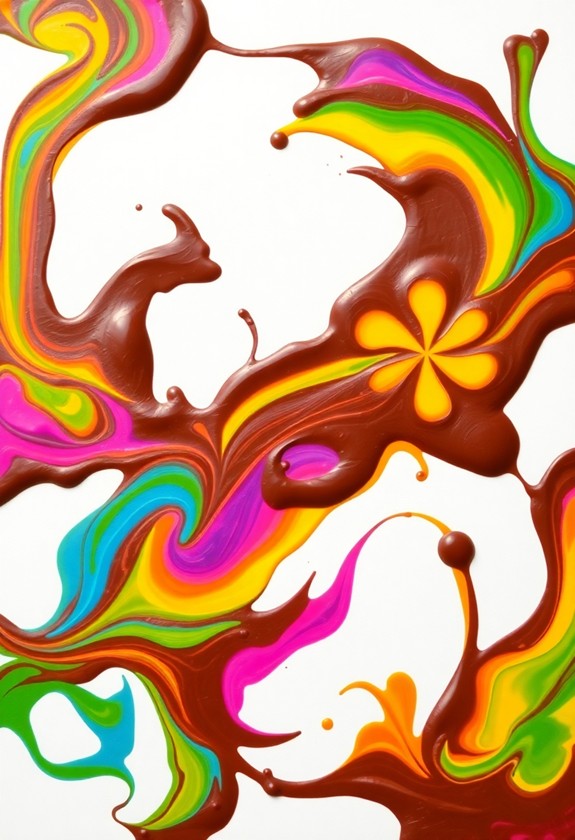
Frequently, toddlers love to examine textures and get messy, making finger painting with pudding an ideal process art activity. It's easy, affordable, and oh-so-fun! This activity enhances sensory investigation and promotes emotional expression, making it particularly beneficial for children with Sensory Processing Disorders. Here's how to do it:
- Gather supplies:
- Instant pudding mix
- Milk
- Large plastic tray or table cover
- Paper
Encourage your toddler to swirl, pat, and navigate the squishy texture. They'll love the sensory experience! And don't worry about the mess – it's all washable. Plus, it's edible! Just be prepared for some giggles and "pudding prints" everywhere.
Pro tip: Try different flavors and colors for even more exciting art adventures!
Bubble Wrap Printing
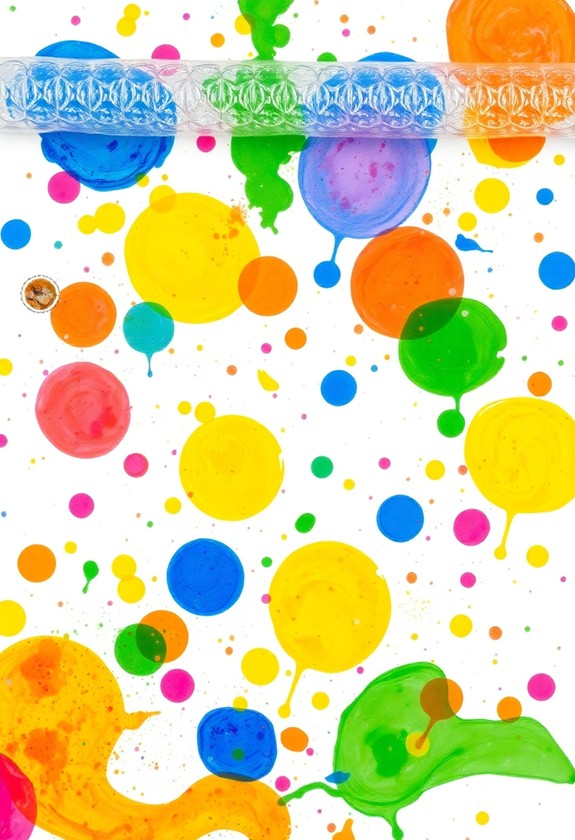
Bubble wrap printing pops up as another fantastic process art activity for toddlers. It's fun, easy, and oh-so-satisfying! Here's how to do it:
- Gather your supplies:
- Bubble wrap
- Washable paint
- Paper
- Scissors
- Paint tray
This mess-free craft promotes sensory play and develops fine motor skills. It's likewise a great portable activity for crafting outside the bedroom.
Watch your toddler's face light up as they create unique patterns and textures. This activity is a sensory delight that'll have them giggling with glee! Plus, it's a great way to introduce them to cause and effect. So, let's get popping with this bubble-tastic art adventure!
Shaving Cream Marbling

Swirling and mixing colors, shaving cream marbling offers a mesmerizing art experience for toddlers. It's easy, affordable, and oh-so-fun! You'll need just a few simple supplies: shaving cream, food coloring, and paper. Squirt a thick layer of shaving cream onto a tray, then add drops of food coloring. Let your little one use a stick or their fingers to swirl the colors together – it's magical! This activity promotes fine motor skills and creative expression, akin to using triangle-shaped crayons and markers. It's likewise a fantastic way to introduce color mixing concepts to young artists.
Here's why toddlers love this activity:
- It's sensory heaven – squishy and smooth!
- They can create unique patterns every time.
- The reveal is like unwrapping a present!
Once they're done swirling, press a sheet of paper onto the shaving cream. Lift it up and scrape off the excess – voila! A beautiful marbled masterpiece appears. It's art and science rolled into one exciting adventure!
Spaghetti Painting
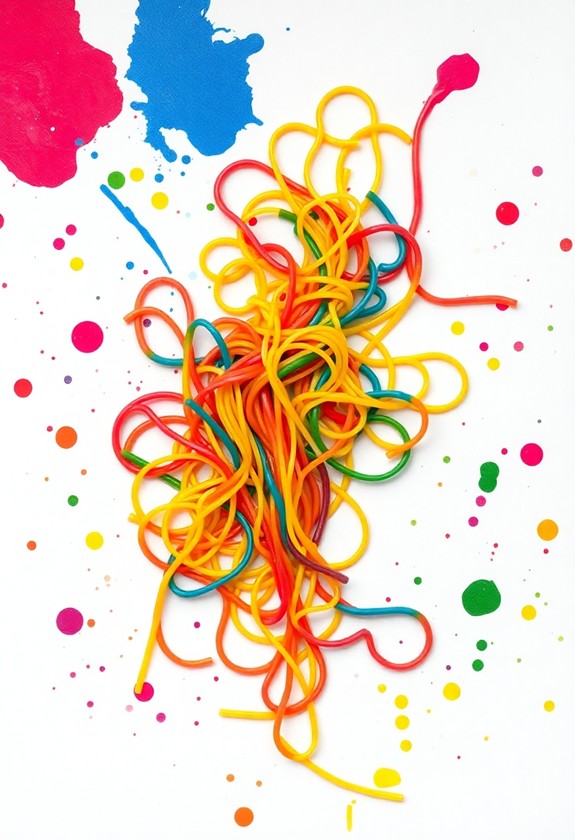
With cooked spaghetti as your paintbrush, you'll unlock a world of textural creativity for your toddler. This messy, sensory-rich activity is guaranteed to delight! Here's how to get started:
- Cook spaghetti until it's soft and pliable
- Lay out large sheets of paper
- Mix paint with a bit of water in shallow containers
- Let your little one dip, drag, and squiggle the noodles!
While non-toxic paints are ideal for this activity, you can likewise use food coloring for a safe alternative. This approach aligns with the growing trend of eco-friendly and sustainable art materials for toddlers.
Watch as they create swirly, spaghetti-tastic masterpieces! The noodles' unique texture will leave behind intriguing patterns and shapes. Plus, it's a fantastic way to develop fine motor skills and hand-eye coordination.
Bonus tip: Add food coloring to the cooking water for rainbow spaghetti painting! But be warned – this "pasta-bility" might just inspire a new love for playing with food!
Coffee Filter Art

Coffee filters offer a surprisingly versatile canvas for toddler art projects. They're cheap, readily available, and perfect for absorbing color! To get started, grab some washable markers, coffee filters, and a spray bottle filled with water. Let your little one scribble all over the filter with markers. Then, watch the magic happen as you spray water onto the filter! The colors will blend and spread, creating beautiful patterns. This activity is excellent for developing fine motor skills and encouraging creativity in young children. Using washable markers guarantees easy cleanup, making it a stress-free experience for parents.
Here are three exciting variations to try:
- Use food coloring instead of markers for lively results
- Fold and dye filters to make colorful butterflies
- Layer multiple filters for a 3D effect
But wait, there's more! Try adding salt or glitter for extra sparkle. And don't forget to display your tot's masterpieces! Hang them in windows for a stained-glass effect that'll make your home shine with creativity.
Homemade Playdough Sculptures
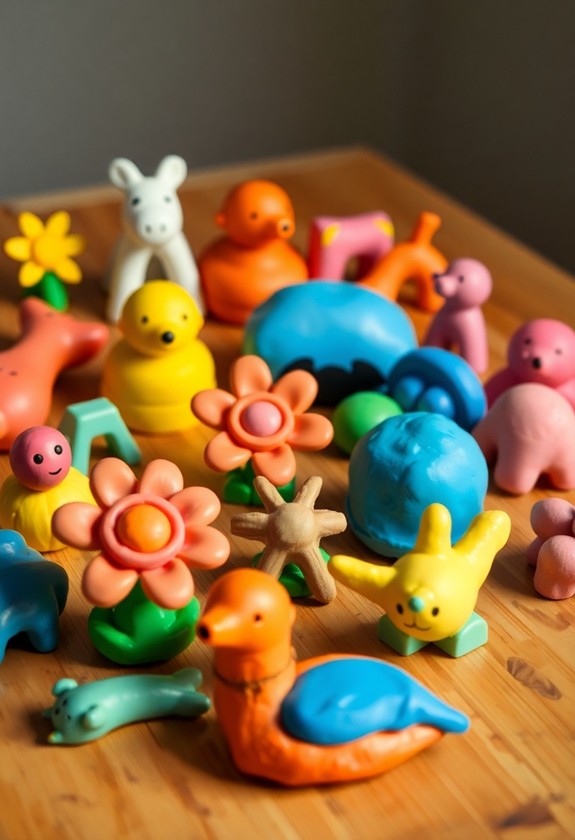
Creating homemade playdough sculptures takes toddler art to a whole new level of tactile fun. It's a squishy, squashy adventure that'll have your little ones giggling with glee! Here's how to get started:
- Mix up a batch of homemade playdough (flour, salt, water, oil, and food coloring)
- Set out tools like:
- Rolling pins
- Cookie cutters
- Plastic knives
- Garlic press (for "hair")
Let your toddler's imagination run wild! They can create:
- Animals
- Monsters
- Flowers
- Anything their heart desires!
Encourage them to mix colors, make textures, and build 3D structures. It's a hands-on learning experience that's both fun and educational. Plus, you can store the playdough for future play sessions. Get ready for some serious "dough-lightful" creativity!
Nature Collages
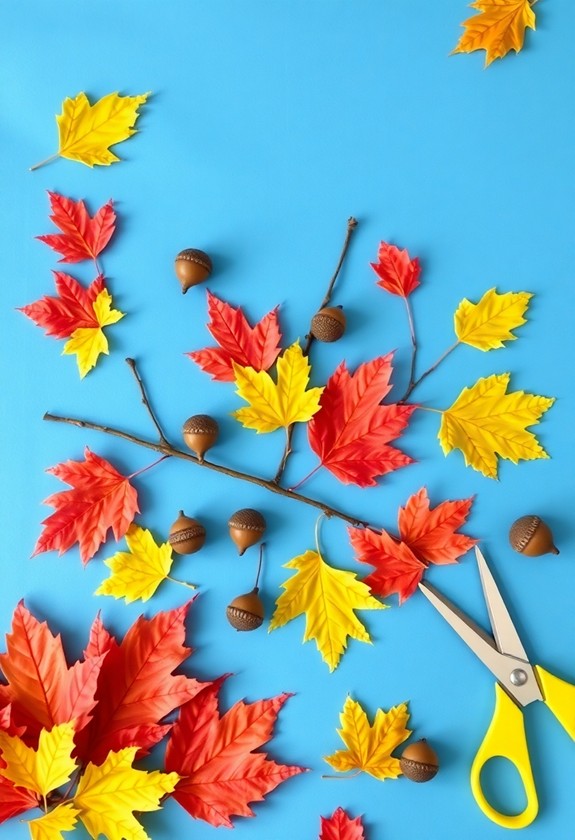
Nature collages offer a wonderful way to combine outdoor exploration with artistic expression. You'll love this activity! First, take your little one on a nature walk to collect materials. Look for colorful leaves, twigs, flowers, and pebbles. It's a treasure hunt!
Back home, spread out your findings on a table. Now it's time to create! Here's what you'll need:
- A sturdy piece of cardboard or paper as the base
- Child-safe glue or tape
- Your natural treasures
Let your toddler arrange the items as they like. There's no right or wrong way! Encourage them to feel the different textures and talk about the colors. Stick everything down when they're happy with the design. Voila! You've got a unique, nature-inspired masterpiece. It's art-tastic!
Curious Little Questions
How Can I Protect My Furniture During Messy Art Activities?
Don't let messy art scare you away from fun! Protect your furniture with these easy tricks:
- Spread old newspapers or plastic tablecloths on surfaces
- Use washable drop cloths for larger areas
- Cover chairs with old sheets or towels
- Create a designated "art zone" with vinyl flooring
- Invest in washable slipcovers for couches
What Age Is Appropriate to Start Process Art With Toddlers?
Imagine this: Your 6-month-old creating a masterpiece! Okay, maybe not quite yet. But you can start process art with toddlers as early as 18 months! That's when they've got better hand control and curiosity. Don't wait too long, though – the sooner, the better! By age 2-3, they'll be ready for more exciting projects. Remember, it's all about the experience, not the end result. So grab those finger paints and let the messy fun begin!
Are There Any Eco-Friendly Alternatives for Art Supplies?
You've got so many eco-friendly options for art supplies. It's amazing! Try these green alternatives:
- Use natural materials like leaves, twigs, and flowers for collages
- Make homemade paint with food coloring and cornstarch
- Create crayons from beeswax and natural pigments
- Craft with recycled paper, cardboard, and fabric scraps
- Use clay or playdough made from kitchen ingredients
These Earth-friendly choices aren't just good for the planet—they're fun and safe for kids too! Get creative and go green with your art supplies!
How Can I Encourage Creativity Without Focusing on the Final Product?
Imagine little Timmy, finger-painting with wild abandon! That's creativity in action! To encourage this, focus on the process, not the product. Let your child investigate freely, without worrying about the end result. Try these fun ideas:
- Set up an "anything goes" art station
- Ask open-ended questions like "What inspired you?"
- Praise their effort and imagination, not just the final piece
What Are Some Ways to Display and Preserve Toddler Artwork?
You've got a budding Picasso on your hands! Let's celebrate their masterpieces! Here are some fun ways to display and preserve your little one's artwork:
- Create a "Gallery Wall" with colorful frames
- Make a scrapbook or portfolio
- Snap photos and create a digital album
- Turn their art into custom gifts (mugs, blankets, etc.)
- Use clothespins and string for an easy rotating display
- Laminate favorite pieces for durability
Don't forget to date each piece! Years from now, you'll love looking back at their artistic adventure. Cherish the creativity!

